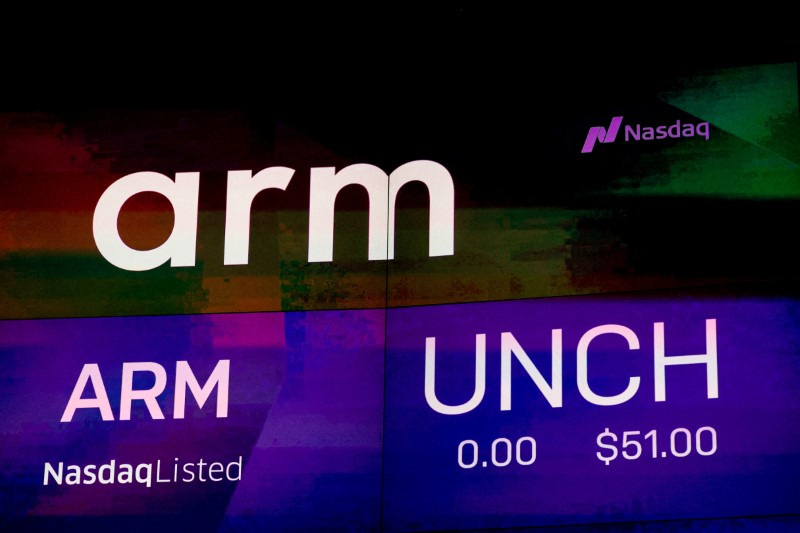By Max A. Cherney, Deborah Mary Sophia
SAN FRANCISCO (Reuters) -Chip designer Arm Holdings (NASDAQ:ARM) on Wednesday forecast revenue in line with Wall Street targets, sparking a 4.5% drop in shares that some analysts attributed to dashed hopes for stronger, AI-fueled growth.
Bets that Arm, which licenses its designs, will benefit from a surge in AI computing have more than doubled the chip designer’s share price since its initial public offer last September, giving it a market value of about $144 billion. Its forecast, however, failed to live up to expectations set by companies like AMD (NASDAQ:AMD) and Nvidia (NASDAQ:NVDA) that directly design AI chips.
“Arm’s done a good job of associating themselves with some of these AI semiconductor trends and the challenge is because they’ve done that, they’ve created expectations perhaps that aren’t quite being met yet,” said Bob O’Donnell, president and chief analyst at TECHnalysis Research. “They’re several steps removed from the final chips,” he added.
Arm results topped revenue and profit expectations for the second quarter on Wednesday, in part because customers like Apple (NASDAQ:AAPL) are using a more profitable version of its next-generation technology.
However, for the current fiscal third quarter, Arm forecast revenue in a range between $920 million and $970 million, with a midpoint of $945 million, compared with an average analyst estimate of $944.3 million, according to LSEG data.
The company said it expects fiscal third-quarter earnings of between 32 cents and 36 cents per share. Analysts had expected a third-quarter profit of 34 cents a share.
“Investors want to see the current AI boom in its results,” said Kinngai Chan, senior research analyst at Summit Insights Group.
“This quarter is all about the validation of the strategies we’ve been talking about,” Chief Executive Rene Haas told Reuters in an interview. “We’ve got some real proof points.”
Arm derives revenue from licensing fees for its chip designs and collects a royalty for each chip sold that uses its technology. The company is in the midst of introducing its v9 architecture, which is expected to generate higher royalty payments.
Arm’s designs power nearly every smartphone in the world, and it has attempted to make headway in data centers and other markets. It has developed a number of pre-built designs that enable customers to build chips more quickly and has doubled the number of pre-built design licenses this fiscal year, the company said.
Haas said the company has signed up its first smartphone chip customer for its premade blueprints. Arm has previously sold those designs to server chip designers.
Arm’s second-quarter revenue rose 5% to $844 million, compared with analyst estimates of $808.4 million.
The UK chip designer reported second-quarter earnings of 30 cents per share, adjusted for stock-based compensation, among other things. Analysts expected earnings of 26 cents a share.
The v9 technology represented 25% of Arm’s revenue for the fiscal second quarter, and its adoption in smartphones assisted the company’s revenue growth. Apple is one such customer, and its latest iPhone 16 series designs include the v9 tech.
“We’re pretty optimistic about the growth rates for mobile, including Apple,” CEO Haas said.
Unlike prior versions of the designs, the company has structured deals for the v9 technology to allow Arm to increase prices over time, and in some cases every year, Haas said. The ability to hike prices on its new technology is crucial to the company’s longer-term growth strategy.
Chips with Arm technology generate $200 billion a year of revenue for the many chipmakers that sell them, according to research from TD Cowen.
Arm has benefited from investor optimism that it will be helped by the boom in artificial intelligence. Shares recently traded at roughly 70 times expected earnings, compared with about 33 times earnings for heavyweight chipmaker Nvidia, according to LSEG data.
The chips based on the company’s blueprints are included in Nvidia’s forthcoming Blackwell AI hardware.
Shares of mobile chip designer Qualcomm (NASDAQ:QCOM) surged 11% in after-hours trading on Wednesday after the company issued a forecast that topped expectations. Qualcomm uses Arm technology in its chips. The two companies are embroiled in litigation around a licensing dispute that is expected to go to trial in December.
(Max A. Cherney in San Francisco and Deborah Sophia in BengaluruEditing by Sayantani Ghosh, Peter Henderson and Matthew Lewis (JO:LEWJ))

